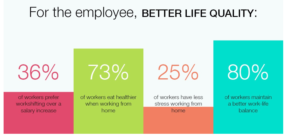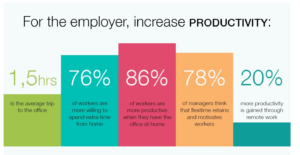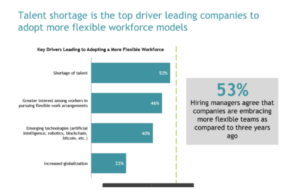[icon name=”home” class=”” unprefixed_class=””]How Remote Working Can Increase Productivity, Commitment, and Efficiency.
[NOTE: I wrote this in Nov 2018 and I am reposting as it seems even more relevant today!]
I will admit right out of the gate that anyone reading this who worked for me in some of my previous roles will be surprised to hear that I have become a huge advocate of the remote working. Well, what can I say, just like the technology has evolved to support remote working effectively, my attitude to it has also evolved.
Since the financial crisis of 2008 many people have gone through a radical reassessment of their relationship with work in general and companies in particular. Traditionally the majority of employees had to locate themselves either close to where the company was physically located which often meant living in high-cost locales or enduring horrendous commutes to live in more affordable areas. In decades past an economic disaster like 2008 which resulted in so many layoffs would have left many people high and dry, desperately searching for another job in the same area as their previous company or trying finding a job with a new company and relocating close to that company’s location. But attitudes have changed since 2008 and many more people are making the decision to choose where they want to live first and then looking for a job that allows them to work remotely second.

There are a variety of reasons driving this change but one of the biggest is the practical calculation of why make the commitment to locate somewhere expensive, close to the company when there is no longer such thing as job security and the possibility of being laid off and stuck with a big mortgage or monthly rental bill is an ever-present concern. And then once you factor in the likely high cost of living, cost of schools, transport etc. it is no wonder that many people are rejecting this option.
Let’s examine this a little more closely. I lived and worked in Silicon Valley during the dot-com era and although it was relatively expensive then, it was nothing compared to today. Many companies, however, including hip startups still locate themselves in Silicon Valley and more of them are choosing to move into the city of San Francisco itself. In many ways, these companies that are trying to be technology disruptors with non-traditional business models are at the same time adopting a very traditional mode of operating by immediately setting up physical offices in a traditional technology location like Silicon Valley and then trying to staff them.
Given the fact that San Francisco according to Best Places is 3 times the national average for cost of living, with housing 7 times more expensive and as SF Gate reports a studio apartments renting at $3000, even $3500 per month, this is becoming less and less a smart move. Particularly given that the majority of the workforce are knowledge workers.
Take a look at the comparison between San Francisco and Austin, Texas from Bestplaces.net:

So let me explain why this is fast becoming an anachronistic way of operating.
If you physically locate your office somewhere like San Francisco and look to recruit people to come into the office regularly you immediately:
- limit your talent pool to a certain geographical radius
- compete against other companies for this limited talent pool and continually battle wage increases and talent poaching
- pay higher salaries to try and offset the higher cost of living
- force some people into horrible, wasted hours commuting increase cars on the road and environmental impact (public transportation is rarely available to most)
- impact negatively the quality of family life for some with “early to leave, late home” commuting
- relocate people from other parts of the country (even world) and pay expensive relocation costs and cost of living salary adjustments
- force some people into cramped, high-cost apartments with little disposal income left after rent payments
Of course, on top of this you are paying for an expensive office and unless you buy the building which is a rare luxury most companies can’t afford, this really brings no investor or shareholder value. Plus you are spending lots of additional money equipping it and then spending even more on parties and gimmicks to convince the employees that all the sacrifices of high costs and commuting are worthwhile.
Given the advances in technology, it all seems rather backward and unenlightened in many ways for companies to adopt this outdated model.

Take a look at what a distributed home office working model can provide employees:
- a choice on where they want to live and raise their family or pursue their interests
- what cost of living they are comfortable with
- more time to spend with family – be there when kids leave for and come back from school for example
- more productive work time and less time in cars or on buses and trains
- more time to exercise and eat more healthily (less take-away food from the places near the office!)
- personal cost savings by eliminating expenditure on gas, automobile wear & tear and the aforementioned lunch overhead

For the company the benefits are just as plentiful:
- limitless talent pool unencumbered by location
- greater potential diversity e.g. geographically, culturally (sometimes being centered in one location can drive insular or myopic thinking)
- more money to invest in people, product and service rather than buildings
- a more environmentally-friendly, family-friendly, people-friendly infrastructure
- employees who are more relaxed, focused, content and therefore more productive
Ok, you might argue that are advantages to people being together in an office for collaboration and culture building but I would counter-argue that today’s technology can pretty much do the same. At Pipeliner, for example, we leverage a variety of SaaS solutions to allow us operate extremely efficiently and productively across our growing network of remote employees (we do have some people such as our programmers who mostly sit together in an office but we try to limit offices to only where it makes more sense than being remote). We use instant communication tools, document sharing, and collaboration, project management tools and of course Pipeliner CRM to manage our business. The collection of technologies we use to connect us in ways that drive and almost demand a greater level of efficiency and teamwork and the productivity gains I have witnessed have converted me to being a true believer in the “home team”.

Now may be a good time for you to re-evaluate how much physical buildings are critical to your business. There are obviously businesses that do require them and maybe always will but certainly for a lot of businesses operating, for instance, in the knowledge economy there really is less and less justification for centralizing people and putting the unnecessary burdens of location and commuting on them – not to mention the cost burden on your P&L.
In other words, maybe it is time you placed your bet on the home team!
Let me know your thoughts in this poll:
[Total_Soft_Poll id=”16″]















































Comments (3)
John, this is a really great article and it shows how to find the best people and today we need in every company the best knowledge workers, they want to live and get out what is best for them. Times are changing and this will be a very important point of consideration to get a new job.
Thanks Nikolaus – yes I think things are changing significantly and the world is a smaller place and technology has become a great democratizing agent.
The current Covid-19 global pandemic has resulted in a great shift of how businesses are adapting remote work technologies. The lockdown forced people to be isolated in their homes, towns and countries, but technology is there to ensure that life can be experienced as normal through adopting such new technologies.